
Indonesian cuisine is a collection of various regional culinary traditions that formed in the archipelagic nation of Indonesia. There are a wide variety of recipes and cuisines in part because Indonesia is composed of approximately 6,000 populated islands of the total 17,508 in the world's largest archipelago, with more than 1,300 ethnic groups.

Malay cuisine is the traditional food of the ethnic Malays of Southeast Asia, residing in modern-day Malaysia, Indonesia, Singapore, Brunei, Southern Thailand and the Philippines as well as Cocos Islands, Christmas Island, Sri Lanka and South Africa.

Gudeg is a traditional Javanese dish from Yogyakarta, in Central Java, Indonesia. Gudeg is made from young, unripe jackfruit stewed for several hours with palm sugar and coconut milk. Additional spices include garlic, shallot, candlenut, coriander seed, galangal, bay leaves, and teak leaves, the latter gives a reddish-brown color to the dish. It is often described as "green jack fruit sweet stew".
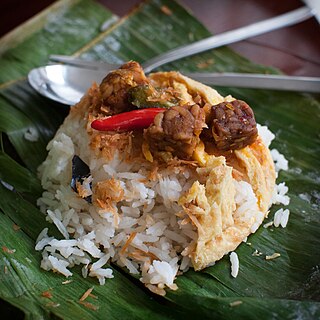
Nasi uduk is an Indonesian-style steamed rice cooked in coconut milk dish, especially popular in Betawi cuisine.
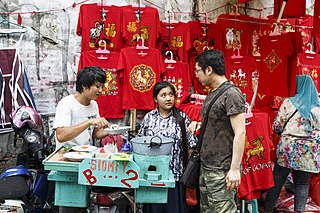
Chinese Indonesian cuisine is characterized by the mixture of Chinese with local Indonesian style. Chinese Indonesians, mostly descendant of Han ethnic Hokkien and Hakka speakers, brought their legacy of Chinese cuisine, and modified some of the dishes with the addition of Indonesian ingredients, such as kecap manis, palm sugar, peanut sauce, chili, santan and local spices to form a hybrid Chinese-Indonesian cuisine. Some of the dishes and cakes share the same style as in Malaysia and Singapore, known as Nyonya cuisine by the Peranakan.

Tea egg is a typical Chinese savory food commonly sold as a snack, in which a boiled egg is cracked slightly and then boiled again in tea, and sauce or spices. It is also known as marble egg because cracks in the egg shell create darkened lines with marble-like patterns. Commonly sold by street vendors or in night markets in most Chinese communities throughout the world, it is also served in Asian restaurants. Although it originated from China and is traditionally associated with Chinese cuisine, other similar recipes and variations have been developed throughout Asia. Tea eggs originated in Zhejiang province as a way to preserve food for a long time but are now found in all provinces.
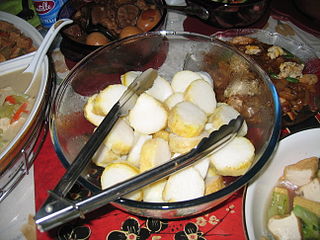
Lontong is an Indonesian dish made of compressed rice cake in the form of a cylinder wrapped inside a banana leaf, commonly found in Indonesia, Malaysia, and Singapore. Rice is rolled inside a banana leaf and boiled, then cut into small cakes as a staple food replacement for steamed rice. The texture is similar to that of ketupat, with the difference being that the ketupat container is made from woven janur fronds, while lontong uses banana leaf instead.

Javanese cuisine is the cuisine of Javanese people, a major ethnic group in Indonesia, more precisely the province of Central Java, Yogyakarta and East Java.

Tumpeng is an Indonesian cone-shaped rice dish with side dishes of vegetables and meat originating from Javanese cuisine of Indonesia. Traditionally featured in the slamatan ceremony, the rice is made by using a cone-shaped woven bamboo container. The rice itself may be plain steamed rice, uduk rice, or yellow rice.
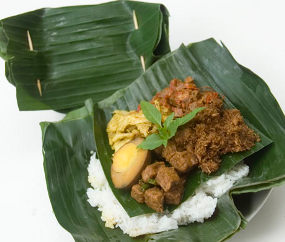
Nasi bogana or nasi begana, pronounced as nah-see boh-gâna, is an Indonesian-style rice dish, originally from Tegal, Central Java. It is usually wrapped in banana leaves and served with side dishes.

Semur is an Indonesian meat stew braised in thick brown gravy. It is commonly found in Indonesian cuisine. The main ingredients in the gravy are sweet soy sauce, shallots, onions, garlic, ginger, candlenut, nutmeg, and cloves.

Soto mie, Soto mi, or Mee soto is a spicy Indonesian noodle soup dish commonly found in Indonesia, Malaysia, and Singapore. Mie means noodle made of flour, salt and egg, while soto refers to Indonesian soup. In Indonesia, it is called soto mie and is considered one variant of soto, while in Malaysia and Singapore it is called mee soto.

Lontong cap go meh is a Chinese Indonesian take on traditional Indonesian dishes, more precisely Javanese cuisine. It is lontong served with richly-flavoured dishes which include opor ayam chicken in coconut milk, sayur lodeh vegetable soup, hot and spicy liver, hard-boiled pindang egg, koya powder made of soy and dried shrimp or beef floss, pickles, chili paste and prawn cracker. Lontong cap go meh is usually consumed by the Chinese Indonesian community during the Cap go meh celebration.
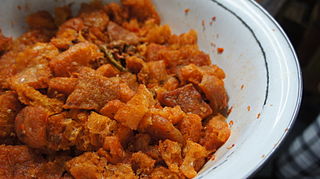
Krechek or krecek or sambal goreng krechek is a traditional Javanese cattle skin spicy stew dish from Yogyakarta and Central Java, Indonesia. Traditionally it is made from the soft inner skin of cattle, however, the most common recipe today uses readily available rambak or krupuk kulit.

Betawi cuisine is rich, diverse and eclectic, in part because the Betawi people that create them were composed from numbers of regional immigrants that came from various places in the Indonesian archipelago, as well as Chinese, Indian, Arab, and European traders, visitors and immigrants that were attracted to the port city of Batavia since centuries ago.

Ketupat, or kupat, or tipat is a Javanese rice cake packed inside a diamond-shaped container of woven palm leaf pouch. Originating in Indonesia, it is also found in Brunei, Malaysia, Singapore, and southern Thailand. It is commonly described as "packed rice", although there are other types of similar packed rice such as lontong and bakchang.

Pindang refers to a cooking method in the Indonesian and Malay language of boiling ingredients in brine or acidic solutions. Usually employed to cook fish or egg, the technique is native to Sumatra especially in Palembang, but has spread to Java and Kalimantan. The term also could refer to a specific sour and spicy fish soup which employs seasonings like tamarind. Pindang has food preservation properties, which extends the shelf life of fish products.

Nasi kari is an Indonesian rice dish from Acehnese, Minangkabau and Malay as well as Javanese cuisine. This rice dish is popular in Sumatra and Java, Indonesia.

Lontong balap is an Indonesian traditional rice dish, well known in Javanese cuisine, made of lontong, tauge, fried tofu, lentho, fried shallots, sambal petis and sweet soy sauce. East Javanese lontong and tofu recipes are known of their distinctive flavour, acquired from generous amount of petis. The origin of the dish is from Surabaya in East Java, Indonesia.




















